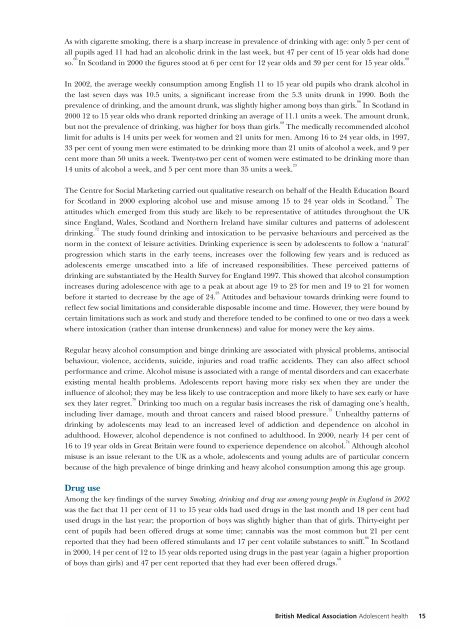Alcohol misuse: tackling the UK epidemic - London
Alcohol misuse: tackling the UK epidemic - London
Alcohol misuse: tackling the UK epidemic - London
You also want an ePaper? Increase the reach of your titles
YUMPU automatically turns print PDFs into web optimized ePapers that Google loves.
As with cigarette smoking, <strong>the</strong>re is a sharp increase in prevalence of drinking with age: only 5 per cent of<br />
all pupils aged 11 had had an alcoholic drink in <strong>the</strong> last week, but 47 per cent of 15 year olds had done<br />
so. 66<br />
In Scotland in 2000 <strong>the</strong> figures stood at 6 per cent for 12 year olds and 39 per cent for 15 year olds. 68<br />
In 2002, <strong>the</strong> average weekly consumption among English 11 to 15 year old pupils who drank alcohol in<br />
<strong>the</strong> last seven days was 10.5 units, a significant increase from <strong>the</strong> 5.3 units drunk in 1990. Both <strong>the</strong><br />
prevalence of drinking, and <strong>the</strong> amount drunk, was slightly higher among boys than girls. 66<br />
In Scotland in<br />
2000 12 to 15 year olds who drank reported drinking an average of 11.1 units a week. The amount drunk,<br />
but not <strong>the</strong> prevalence of drinking, was higher for boys than girls. 68<br />
The medically recommended alcohol<br />
limit for adults is 14 units per week for women and 21 units for men. Among 16 to 24 year olds, in 1997,<br />
33 per cent of young men were estimated to be drinking more than 21 units of alcohol a week, and 9 per<br />
cent more than 50 units a week. Twenty-two per cent of women were estimated to be drinking more than<br />
14 units of alcohol a week, and 5 per cent more than 35 units a week. 23<br />
The Centre for Social Marketing carried out qualitative research on behalf of <strong>the</strong> Health Education Board<br />
for Scotland in 2000 exploring alcohol use and <strong>misuse</strong> among 15 to 24 year olds in Scotland. 71<br />
The<br />
attitudes which emerged from this study are likely to be representative of attitudes throughout <strong>the</strong> <strong>UK</strong><br />
since England, Wales, Scotland and Nor<strong>the</strong>rn Ireland have similar cultures and patterns of adolescent<br />
drinking. 72<br />
The study found drinking and intoxication to be pervasive behaviours and perceived as <strong>the</strong><br />
norm in <strong>the</strong> context of leisure activities. Drinking experience is seen by adolescents to follow a ‘natural’<br />
progression which starts in <strong>the</strong> early teens, increases over <strong>the</strong> following few years and is reduced as<br />
adolescents emerge unsca<strong>the</strong>d into a life of increased responsibilities. These perceived patterns of<br />
drinking are substantiated by <strong>the</strong> Health Survey for England 1997. This showed that alcohol consumption<br />
increases during adolescence with age to a peak at about age 19 to 23 for men and 19 to 21 for women<br />
before it started to decrease by <strong>the</strong> age of 24. 23<br />
Attitudes and behaviour towards drinking were found to<br />
reflect few social limitations and considerable disposable income and time. However, <strong>the</strong>y were bound by<br />
certain limitations such as work and study and <strong>the</strong>refore tended to be confined to one or two days a week<br />
where intoxication (ra<strong>the</strong>r than intense drunkenness) and value for money were <strong>the</strong> key aims.<br />
Regular heavy alcohol consumption and binge drinking are associated with physical problems, antisocial<br />
behaviour, violence, accidents, suicide, injuries and road traffic accidents. They can also affect school<br />
performance and crime. <strong>Alcohol</strong> <strong>misuse</strong> is associated with a range of mental disorders and can exacerbate<br />
existing mental health problems. Adolescents report having more risky sex when <strong>the</strong>y are under <strong>the</strong><br />
influence of alcohol; <strong>the</strong>y may be less likely to use contraception and more likely to have sex early or have<br />
sex <strong>the</strong>y later regret. 70<br />
Drinking too much on a regular basis increases <strong>the</strong> risk of damaging one’s health,<br />
including liver damage, mouth and throat cancers and raised blood pressure. 73<br />
Unhealthy patterns of<br />
drinking by adolescents may lead to an increased level of addiction and dependence on alcohol in<br />
adulthood. However, alcohol dependence is not confined to adulthood. In 2000, nearly 14 per cent of<br />
16 to 19 year olds in Great Britain were found to experience dependence on alcohol. 74<br />
Although alcohol<br />
<strong>misuse</strong> is an issue relevant to <strong>the</strong> <strong>UK</strong> as a whole, adolescents and young adults are of particular concern<br />
because of <strong>the</strong> high prevalence of binge drinking and heavy alcohol consumption among this age group.<br />
Drug use<br />
Among <strong>the</strong> key findings of <strong>the</strong> survey Smoking, drinking and drug use among young people in England in 2002<br />
was <strong>the</strong> fact that 11 per cent of 11 to 15 year olds had used drugs in <strong>the</strong> last month and 18 per cent had<br />
used drugs in <strong>the</strong> last year; <strong>the</strong> proportion of boys was slightly higher than that of girls. Thirty-eight per<br />
cent of pupils had been offered drugs at some time; cannabis was <strong>the</strong> most common but 21 per cent<br />
reported that <strong>the</strong>y had been offered stimulants and 17 per cent volatile substances to sniff. 66<br />
In Scotland<br />
in 2000, 14 per cent of 12 to 15 year olds reported using drugs in <strong>the</strong> past year (again a higher proportion<br />
of boys than girls) and 47 per cent reported that <strong>the</strong>y had ever been offered drugs. 68<br />
British Medical Association Adolescent health 15
















